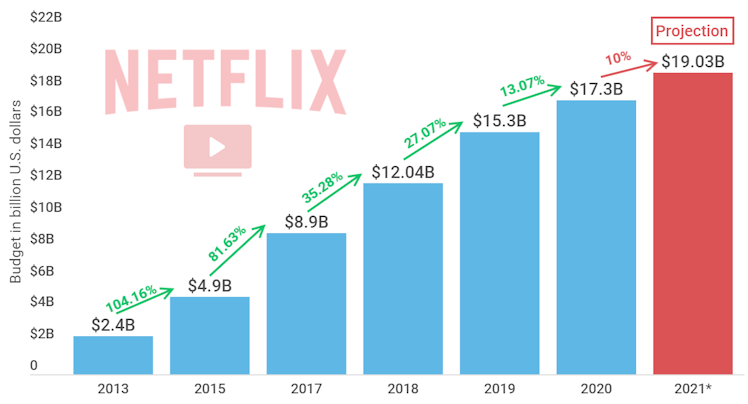Trending Assets
Top investors this month
Trending Assets
Top investors this month
Ads are why streaming companies will become profitable
What do Youtube and some of the streaming services (with ads) have in common?
Their earnings correlate with the amount of watch time happening on the platform.
$NFLX is the pioneer of streaming. For years, they've tried to make it work by relying solely on subscription revenues and nothing more. People can watch as much content as they want and Netflix still generated the same amount of revenue. With a business model like that, learning about the number of hours an average subscriber spends on the platform doesn't matter. After years of trying, they've only reached profitability for a few quarters and then return to producing negative free cash flow.
Other streaming platforms like Hulu, Peacock, and soon, Disney+, are dabbling into ads on-top of subscriptions as a way to enhance the chances of profitability with their streaming efforts. $PARA $WBD and other entertainment studios choose to make movies and release them in theaters first and then release them in their streaming service a month or two after being in theaters.
Without those movie theater profits, these entertainment companies would be burning cash because of the unprofitability aspects of streaming.
Netflix investors theorized that if Netflix reached a certain number of subscribers, then it would reach profitability. That's why, as the market saturated, Netflix became more focused on cracking down on password sharing than on expanding internationally. The firm is unprofitable, management blamed the cash burn on password-sharing people and knew that its best way of getting more subscribers with less spending on marketing and other things is to crack down on those types of people.
Interestingly, as Netflix gained more subscribers, Netflix thought that it needed to spend more on content creation to keep those subscribers and possibly get more subscribers. Sure, some of that expansion in content creation is because, in certain countries, the streaming platform needs to have at least a certain percentage of their library be of content that was produced in that country. But after expanding to so many countries and seeing a massive slowdown in entrances into new countries (I mean, Netflix is nearly in every country except Iran, North Korea, Cuba, Venezuela, and other nations that are either unfriendly to the US or that aren't great streaming markets), Netflix's content creation spending kept growing.

If Netflix was barely able to achieve profitability in some instances from relying on subscriptions, what are the chances that other entertainment studios can make money from subscriptions? How can other streaming companies achieve the same number of subscribers as Netflix when subscription fatigue is becoming a major theme of consumer sentiment?
Disney is best able to overcome those odds, but Disney+ isn't profitable (yet).
With that, streaming companies are looking to implement ads on their platform while charging monthly from their subscribers. That way, streaming companies get some sort of recurring revenue while pursuing streaming efforts and consumers pay less for entertainment every month. Once these streaming companies know how consistent their revenues will be from ads, they'll start becoming comfortable with dropping the subscription payments and making their platforms free for anyone to access and the entertainment companies bank on the ad revenue that comes with viewership. Warner Bros Discovery seems to be the first to consider it and if they succeed, more will follow.
By skewing the incentives for streaming companies on prioritizing quality content over quantity of content, entertainment companies will cut down on overall content spending and choose to work with fewer higher quality projects over numerous projects where the majority of them will barely get over 10,000 views (I'm exaggerating, but you understand what I mean by these projects being low quality). People rewatch Friends, The Office, various Star Wars shows, and Euphoria many times. Their budgets are higher than your average TV show, but the huge number of viewers and the repeat viewership of these shows make it more worthwhile to produce those high-quality shows over an average boring show.
Example: The Walking Dead (boring, people normally watch once and move on) cost $2.75 million per episode. Euphoria, cost $11 million per episode but people continue to rewatch the episodes from time to time and continue to talk about it even if it has been months since a season finale was released.
The lower-budget shows are great for generating quick bucks as long as viewership remains stable. Meanwhile, the more expensive shows are great for generating consistent ad revenue. They're fantastic to have especially in times when movie production is restricted (pandemic, lack of funds, etc.). Lower-budget shows, in my view, have a bigger risk of becoming unprofitable because it's difficult to inspire someone to watch a new show. If they're hooked and enjoyed the first season of the show, then it's guaranteed that they'll watch the second season of the show. If they didn't like the first season of the show, it'll be harder to convince them to consider watching the second season of the show. At the same time, we don't know how the dynamics of content creation and streaming will be in the future.
Overall, ads are going to help streaming companies improve the economics of streaming and will surely make streaming a profitable business (on a cash basis, of course). Streaming service providers will look more like Youtube than a SaaS company because of this.
The Hollywood Reporter
‘The Walking Dead’: What Really Happened to Fired Showrunner Frank Darabont
The cast is "scared," the crew is crushed after Darabont is canned while working to fix an episode that a director turned in with unusable footage.
Already have an account?